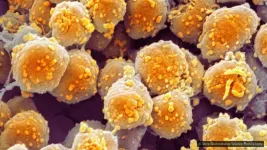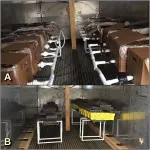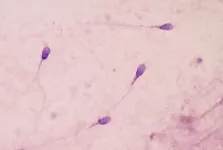INFORMATION:
The researchers were supported by Alzheimer's Research UK, Wellcome, and the National Institute for Health Research UCLH Biomedical Research Centre.
Eye tests predict Parkinson's-linked cognitive decline 18 months ahead
2021-01-19
(Press-News.org) Simple vision tests can predict which people with Parkinson's disease will develop cognitive impairment and possible dementia 18 months later, according to a new study by UCL researchers.
The study, published in Movement Disorders, adds to evidence that vision changes precede the cognitive decline that occurs in many, but not all, people with Parkinson's.
In another new study published today in Communications Biology, the same research team found that structural and functional connections of brain regions become decoupled throughout the entire brain in people with Parkinson's disease, particularly among people with vision problems.
The two studies together show how losses and changes to the brain's wiring underlie the cognitive impairment experienced by many people with Parkinson's disease.
Lead author Dr Angeliki Zarkali (Dementia Research Centre, UCL Queen Square Institute of Neurology) said: "We have found that people with Parkinson's disease who have visual problems are more likely to get dementia, and that appears to be explained by underlying changes to their brain wiring.
"Vision tests might provide us with a window of opportunity to predict Parkinson's dementia before it begins, which may help us find ways to stop the cognitive decline before it's too late."
For the Movement Disorders paper, published earlier this month, the researchers studied 77 people with Parkinson's disease and found that simple vision tests predicted who would go on to get dementia after a year and a half.
Dementia is a common, debilitating aspect of Parkinson's disease, estimated to affect roughly 50% of people within 10 years of a Parkinson's diagnosis.
These longitudinal findings add weight to previous studies that were done at one time point, which had suggested that performance in vision tests, involving commonly used eye charts and skewed images of cats and dogs, was linked to the risk of cognitive decline.
The new study also found that those who went on to develop Parkinson's dementia had losses in the wiring of the brain, including in areas relating to vision and memory. The researchers used recently developed methods to analyse finely detailed MRI scans, enabling them to pick up the damage to the brain's white matter.
The researchers identified white matter damage to some of the long-distance wiring connecting the front and back of the brain, which helps the brain to function as a cohesive whole network.
The Communications Biology study involved 88 people with Parkinson's disease (33 of whom had visual dysfunction and were thus judged to have a high risk of dementia) and 30 healthy adults as a control group, whose brains were imaged using MRI scans.
In the healthy brain, there is a correlation between how strong the structural (physical) connections between two regions are, and how much those two regions are connected functionally. That coupling is not uniform across the brain, as there is some degree of decoupling in the healthy brain, particularly in areas involved in higher-order processing, which might provide the flexibility to enable abstract reasoning. Too much decoupling appears to be linked to poor outcomes.
The researchers found that people with Parkinson's disease exhibited a higher degree of decoupling across the whole brain. Areas at the back of the brain, and less specialised areas, had the most decoupling in Parkinson's patients.
Parkinson's patients with visual dysfunction had more decoupling in some, but not all brain regions, particularly in memory-related regions in the temporal lobe.
The research team also found changes to the levels of some neurotransmitters (chemical messengers) in people at risk of cognitive decline, suggesting that receptors for those transmitters may be potential targets for new drug treatments for Parkinson's dementia. Notably, while dopamine is known to be implicated in Parkinson's, the researchers found that other neurotransmitters - acetylcholine, serotonin and noradrenaline - were particularly affected in people at risk of cognitive decline.
Dr Angeliki said: "The two papers together help us to understand what's going on in the brains of people with Parkinson's who experience cognitive decline, as it appears to be driven by a breakdown in the wiring that connects different brain regions."
Dr Rimona Weil (UCL Queen Square Institute of Neurology), senior author of both papers, said: "Our findings could be valuable for clinical trials, by showing that vision tests can help us identify who we should be targeting for trials of new drugs that might be able to slow Parkinson's. And ultimately if effective treatments are found, then these simple tests may help us identify who will benefit from which treatments."
ELSE PRESS RELEASES FROM THIS DATE:
How short circuits in lithium metal batteries can be prevented
2021-01-19
There are high hopes for the next generation of high energy-density lithium metal batteries, but before they can be used in our vehicles, there are crucial problems to solve. An international research team led by Chalmers University of Technology, Sweden, has now developed concrete guidelines for how the batteries should be charged and operated, maximising efficiency while minimising the risk of short circuits.
Lithium metal batteries are one of several promising concepts that could eventually replace the lithium-ion batteries which are currently widely used - particularly in various types of electric vehicles.
The big advantage of this new battery type is that the energy density can be significantly ...
Ohio State-led support program suggests a reduction in preterm birth and infant mortality
2021-01-19
New research suggests a unique program called Moms2B at The Ohio State University Wexner Medical Center shows a reduction in adverse pregnancy outcomes in communities disproportionately affected by these public health issues.
The study, led by researchers Courtney Lynch and Erinn Hade and published in the Journal of Maternal and Child Health, indicates that women who attended at least two Moms2B sessions may have lower rates of preterm birth, low birth weight and infant mortality compared to women who only received individual care.
"When we started the program 10 years ago, ...
Dinosaur-era sea lizard had teeth like a shark
2021-01-19
New study identifies a bizarre new species suggesting that giant marine lizards thrived before the asteroid wiped them out 66 million years ago.
A new species of mosasaur - an ancient sea-going lizard from the age of dinosaurs - has been found with shark-like teeth that gave it a deadly slicing bite.
Xenodens calminechari, from the Cretaceous of Morocco, had knifelike teeth that were packed edge to edge to make a serrated blade and resemble those of certain sharks. The cutting teeth let the small, agile mosasaur, about the size of a small porpoise, punch above its weight, cutting fish in half and taking large bites from bigger animals.
Dr Nick Longrich, Senior Lecturer at the Milner Centre for Evolution at the University of Bath and lead author on ...
Clumsy kids can be fit too
2021-01-19
Clumsy kids can be as aerobically fit as their peers with better motor skills, a new Finnish study shows. The results are based on research conducted at the Faculty of Sport and Health Sciences of the University of Jyväskylä and the Institute of Biomedicine of the University of Eastern Finland, and they were published in Translational Sports Medicine.
Aerobic fitness doesn't go hand in hand with motor skills
According to the general perception, fit kids also have good motor skills, while low aerobic fitness has been thought to be a link ...
Using ancient fossils and gravitational-wave science to predict earth's future
2021-01-19
A group of international scientists, including an Australian astrophysicist, has used knowhow from gravitational wave astronomy (used to find black holes in space) to study ancient marine fossils as a predictor of climate change.
The research, published in the journal Climate of the Past, is a unique collaboration between palaeontologists, astrophysicists and mathematicians - to improve the accuracy of a palaeo-thermometer, which can use fossil evidence of climate change to predict what is likely to happen to the Earth in coming decades.
Professor Ilya Mandel, from the ARC Centre of Excellence in Gravitational Wave Discovery (OzGrav), and colleagues, studied biomarkers left behind by tiny single-cell organisms called archaea in the distant past, including the Cretaceous period ...
New heat method kills pathogens with minimal damage to plants
2021-01-19
In the strawberry nursery industry, a nursery's reputation relies on their ability to produce disease- and insect-free plants. The best way to produce clean plants is to start with clean planting stock. Many nurseries struggle with angular leaf spot of strawberry, a serious disease that can result in severe losses either by directly damaging the plant or indirectly through a violation of quarantine standards within the industry.
Angular leaf spot is caused by the bacterial pathogen Xanthomonas fragariae. Current management strategies rely primarily ...
How to find mutated sperm? Just go FISH
2021-01-19
Chemotherapy and radiation treatments are known to cause harsh side effects that patients can see or feel throughout their bodies. Yet there are additional, unseen and often undiscussed consequences of these important therapies: the impacts on their future pregnancies and hopes for healthy children.
Extensive evidence shows that chemotherapy and radiation treatments are genotoxic, meaning they can mutate the DNA and damage chromosomes in patients' cancerous and noncancerous cells alike. When this occurs in a germline cell - which are egg cells in women and sperm in men - it can lead to serious fetal and birth ...
Nano-thin piezoelectrics advance self-powered electronics
2021-01-19
A new type of ultra-efficient, nano-thin material could advance self-powered electronics, wearable technologies and even deliver pacemakers powered by heart beats.
The flexible and printable piezoelectric material, which can convert mechanical pressure into electrical energy, has been developed by an Australian research team led by RMIT University.
It is 100,000 times thinner than a human hair and 800% more efficient than other piezoelectrics based on similar non-toxic materials.
Importantly, researchers say it can be easily fabricated through a cost-effective and commercially scalable method, using ...
General health checkups may detect early signs of Parkinson's disease
2021-01-19
A research team led by Nagoya University in Japan has found that blood pressure, the hematocrit (the percentage of red blood cells in blood), and serum cholesterol levels change in patients with Parkinson's disease long before the onset of motor symptoms. This finding, which was recently published online in Scientific Reports, may pave the way for early diagnosis and treatment of the disease.
Parkinson's disease, the second most common disease affecting the nervous system after Alzheimer's disease, is caused by a deficiency in a neurotransmitter called dopamine. It is known that more than half of all dopaminergic neurons are already lost in patients with Parkinson's disease in the stage wherein they ...
Could "Power Walking" fuel the energy revolution? India is ready to step up
2021-01-19
India has an energy problem. It currently relies heavily on coal and consumer demand is expected to double by 2040, making its green energy targets look out of reach. Part of the solution could come from harvesting energy from footsteps, say Hari Anand and Binod Kumar Singh from the University of Petroleum and Energy Studies in Dehradun, India. Their new study, published in the De Gruyter journal Energy Harvesting and Systems, shows that Indian attitudes towards power generated through piezoelectric tiles are overwhelmingly positive.
Cities like Delhi and Mumbai are famously crowded, especially at railway stations, temples and big commercial buildings. This led researchers to wonder whether piezoelectric tiles, which produce ...







